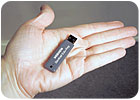Philip Russo, Webview president, says the driving force behind developing this product was to make machine vision compact, smart and affordable. “During the years that Webview has done system integration, we’ve been told many times that machine vision is too expensive,” he explains. “So we decided (with this program) to make it affordable. We were able to reduce the cost and size of the package and make it environmentally friendly. Power usage is much lower than with traditional systems; yet, output is powerful.”
In the past, machine vision required the use of large computer, rack- mounted systems that cost up to $200,000, according to Russo. Systems are now available in the $20,000 to $40,000 range. In contrast, the Sentinel system is priced around $3,000. Thus, it is being marketed as an affordable solution to parts inspection.

The Sentinel’s on-board sensor uses light from the object being scanned and digitizes the signal for processing by the FPGA. The FPGA can run custom and standard intellectual property (IP) cores that execute DSP functions at video rates on the data. The camera can operate standalone or, when connected to a host computer running Windows XP or 2000, can display and archive images and reports. It is set up from the computer and begins inspection at power-up.

Besides adaptability and low power consumption, the following attributes are noted by the manufacturer: small footprint; easy setup with Edu-Key or PC; choice of sensors-area array or line scan; USB 2.0 communication (480 Mbps); single 24VDC supply; remote sensor head option; multiple camera imaging; optically isolated inputs and outputs; ability to control and strobe illumination sources.

Education
The Edu-Key programming feature is a key attribute of the Sentinel series. Webview offers a range of Edu-Keys, which contain all the parameters necessary to inspect a particular part. This eliminates the need to reprogram for different products; instead, the operator merely plugs in a new Edu-Key.“For most companies that use machine vision, continuing cost is a major concern,” Russo remarks. “To change inspection parameters, they either use an in-house software writer or hire an outside integrator. With this system, the operator plugs in the Edu-Key which, in effect, becomes a teacher to the camera. It allows the operator to achieve the result at a low cost. Within minutes, he is up and running with a new inspection process. In essence, Edu-Key allows the operator to be comfortable making changes within a short time frame.”
Russo says that with traditional smart cameras, in most cases, the machine operator or integrator must write a software routine or program to achieve the desired inspection. However, Webview can draw on its 35 years of field experience to offer a virtual library that can be customized for almost any inspection and setup in the camera using the Edu-Key module or a PC.
“The Edu-Key programming feature and proven algorithms make it possible for owners to standardize on one system, with one software platform doing different inspection routines at each of their plants worldwide. Sentinel units are registered by serial number, which includes any Edu-Key routines provided for that unit, so that replacement can be accomplished by overnight shipment,” Russo says.
Quality Specs
• On-board sensor uses light from the object being scanned and digitizes the signal for processing by the FPGA.• Camera can scan both linearly or radially for defects.
• Multiple cameras can be used on a single production line for more complex inspections.
TECHNOLOGY CONTACT
For more information on the Sentinel Smart Camera, contact:
Webview Inc.
3418A Standish Ave.
Santa Rosa, CA 95407
(707) 588-7982
E-mail: [email protected]
URL: www.webspec.com